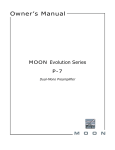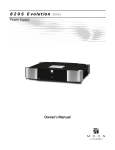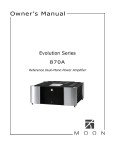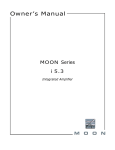Download Simaudio MOON P-3 Owner`s manual
Transcript
P-5 Dual-Mono Preamplifier ___________________________________________________________________________ Owner’s Manual MOON P-5 Dual-Mono Preamplifier Table of Contents Congratulations........................................... 3 Introduction ............................................... 4 Unpacking and Warnings .............................. 5 Installation Tips ........................................ 6 Front Panel Controls .................................... 7 Rear Panel Connections................................ 9 Connecting the PS-5 Power Supply .............. 10 Operating the P-5 .................................... 11 Remote Control Operation .......................... 12 Specifications .......................................... 13 Service and Warranty ................................ 14 www.simaudio.com IMPORTANT: Please read this entire manual before using this product. Installation and operating instructions inside. ____________________________________________________________________________________ MOON P-5 Dual-Mono Preamplifier Congratulations! Thank you for selecting the MOON P-5 Dual-Mono preamplifier as a part of your hi-fi reproduction system. This preamplifier has been designed to offer state-of-the-art high-end performance in an elegant package, while retaining all the sonic hallmarks on which Simaudio has made its reputation. We have spared no effort to ensure that it is among the finest two-channel preamplifiers available. We have been building high performance audio equipment for over 20 years, and the know-how gained through our cumulative experience is an important reason why MOON preamplifiers are so musically satisfying. Your new preamplifier is a true Dual-Mono design, whereby each of the two channels’ audio circuitry operates completely independent of the other. The performance of your P-5 will continue to improve during the first six weeks of use. This is the result of a “break-in” period required for the numerous high quality electronic parts used throughout this amplifier. Please read this manual thoroughly to acquaint yourself with this product’s features prior to using it. We hope you enjoy listening to the MOON P-5 Dual-Mono preamplifier as much as the pride we have taken in creating this fine audio product. We understand the power and emotion of music and build our products with the goal of reproducing these elusive qualities. ____________________________________________________________________________________ Congratulations 3 MOON P-5 Dual-Mono Preamplifier Introduction Your MOON P-5 Dual-Mono preamplifier incorporates many significant design features to achieve its “world class” level of performance. This is an abbreviated list of the more important features: A custom proprietary toroidal transformer design with lower magnetic, electrical and thermal loss, yielding an improved power transfer and lower regulation factor, resulting in increased current speed and better dynamics. Fully balanced differential circuitry throughout the entire preamplifier. An oversized power supply housed in a separate matching chassis. Eight stages of DC voltage regulation. An exceptionally short, capacitor-free signal path measuring only nine inches in length for a faster transient response. Open-loop zero feedback circuit topology. Proprietary designed “RGB” fully discrete “shunt to ground” gain stage employing a precision relay network which uses only one metal film resistor at any given time (rather than a series of resistors), for the audio signal to pass through, resulting in a gain control that doesn't degrade sonic performance regardless of the selected setting. J-FET input devices and MOSFET output devices. One single-ended audio input which functions as a “pass-through”, which bypasses the gain stage to accommodate a component such as a home-theater processor, whose own volume control is used instead. Extremely rigid chassis construction to minimize the effects of external vibrations. Accurate matching of the very finest high quality electronic components. A symmetrical circuit design. Pure copper circuit board tracings with extremely low impedance characteristics. Designed to be powered up at all times for optimal performance. Low operating temperature for a longer than normal life expectancy. ____________________________________________________________________________________ Introduction 4 MOON P-5 Dual-Mono Preamplifier Unpacking and Warning! The MOON P-5 Dual-Mono preamplifier and the MOON PS-5 power supply should both be removed from their box with care. The following accessories should be included inside the box with your preamplifier: 9 AC power cable ‘FRM’ Full Function remote control with three ‘AAA’ batteries (USA and Canada only) 9 8 Pointed screw-on tips (for the preamplifier’s and power supply’s legs) 9 This owner’s manual 9 Warranty card (USA and Canada only) 9 As soon as the preamplifier and its power supply are safely removed from its box and placed down, perform a thorough physical inspection and report any physical damage to your dealer immediately. We suggest that you keep the original packaging, and that it should be stored in a safe, dry place in case you’re required to transport the preamplifier. The customized packaging is specially designed to protect the preamplifier from potential damage that can arise when shipping such a product. ________________________________________________________________ WARNING! To reduce the risk of fire or electric shock, do not expose this product to rain or moisture. Do not attempt to “lift the ground” by removing the ground pin from the AC cable. Make sure that your household electrical wiring supports proper AC grounding techniques before plugging in this product. Keep the heat sinks and top cover free of dust to allow for proper heat dissipation. Never expose this product to extreme temperatures. Always connect the audio signal path cables prior to connecting the AC mains. CAUTION! No user-serviceable parts inside. Do not remove top cover, as severe electrical shock may result. IMPORTANT! Make sure that your local AC voltage complies with the unit’s label. Damage caused by plugging thus amplifier into an AC receptacle of the wrong voltage will not be covered by warranty. ____________________________________________________________________________________ Unpacking and Warning 5 MOON P-5 Dual-Mono Preamplifier Installation Tips Both the MOON P-5 Dual-Mono preamplifier and MOON PS-5 power supply should be placed on rigid surfaces to prevent any accidents such as falling over. It is highly recommended that each unit sit on its own dedicated shelf. This preamplifier and accompanying power supply have side-mounted heat sinks; Consequently, they should both be placed in a location with empty space around them for proper heat dissipation. You should never place another component on top of either unit. As well, you should avoid placing them near a heat source or inside a closed cabinet that is not well ventilated. This could compromise the preamplifier’s performance and reliability. Although well shielded, the power supply chassis should not be placed too close to source components sensitive to EMI, such as turntables, phono preamplifiers and CD Players. Once you have decided on a location for both the P-5 and PS-5, you should install the eight (8) pointed screw-on tips onto the cones of both chassis. These tips will easily scratch most surfaces, therefore it’s advisable to follow these instructions: 1) 2) 3) 4) Place your P-5 on a soft surface (i.e. carpet) and carefully turn it so that it rests on its side. Screw one tip onto each of the four cones. Repeat steps 1) and 2) for the PS-5. Carefully move each chassis to it’s pre-determined location. Included with these tips is a small metal rod, intended for final adjustments (if necessary) by simply threading it through the tiny hole of each of these tips and then gently turning. These adjustable screw-on tips serve two purposes: Mechanical grounding of each chassis and compensation for surfaces that aren’t perfectly level. Since household dust is an excellent insulator of heat, we suggest that you clean both of the curved side-mounted heat sinks on a regular basis. A smooth nylon brush with long bristles (ie. paint brush) is recommended for this task. Finally, you should make all of your audio signal connections prior to making the AC connection between the PS-5 power supply and the AC wall outlet. ____________________________________________________________________________________ Installation Tips 6 MOON P-5 Dual-Mono Preamplifier Front Panel Controls Figure 1: Front panel of Moon P-5 Dual-Mono Preamplifier The front panel will look similar to Figure 1 (above). The large digital display window indicates the relative gain setting (from ‘0’ to ‘50’) for both the left and right channels. As well, whenever you change the selected input source, it’s number will appear in the window for 3 seconds before reverting back to the gain setting. Directly to the right of the digital display window is a button labeled “Display” which allows you to turn the digital display on and off. The sonic performance of the MOON P-5 Dual-Mono preamplifier may improve slightly when the display is turned off simply because the power supply has one less task to perform. The “Stand by/On” button disengages the input section from the rest of the P-5’s circuitry and turns off the digital display. However, when in “Stand by” mode all audio circuitry remains powered up to help maintain optimal performance. When switching back from “Stand by” to the “on” mode, both the ‘input’ and gain level settings will be memorized from the previous listening session. The blue pilot LED will not be illuminated when the P-5 is in “Stand by” mode, however the PS-5’s LED will remain on. The “Monitor” button switches the output signal for the “tape out” on and off. The output level is fixed and therefore independent of the P-5’s gain setting. A small round LED will illuminate in the lower right corner of the display window when the “Monitor” is on. As a result of the proprietary gain stage design used in this preamplifier, the gain setting must be greater than ‘0’ for an output signal to reach the “tape out”. The “Mute” button triggers a decrease in the output gain setting to a factor of 10% of the current setting. For example, if your current setting was ‘30’ and you pressed the “Mute” button, the gain setting will drop to ‘3’. Pressing the “Mute” button a second time will reinstate the output gain level back to ‘30’. ____________________________________________________________________________________ Front Panel Controls 7 MOON P-5 Dual-Mono Preamplifier Front Panel Controls (continued) The “Input” selector button allows you to choose which input source you wish to listen to. The MOON P-5 Dual-Mono preamplifier has six (6) inputs. Five (5) of these inputs use single-ended RCA connectors (CD and A1 through A4), and one uses balanced XLR connectors (A5). The A4 input is a ‘pass-through’ which bypasses the P-5’s gain section, allowing you to control the gain setting via the source component’s own volume control – a home theater processor for example. Adjusting the volume on the P-5 will have no effect whatsoever when the A4 input is selected. Pressing the “Input” selector button allows you to sequentially cascade through each of the possible inputs in the following order: CD, A1, A2, A3, A4 and A5. Holding down the “Input” will allow only a single change of the selected input. You must press the button again to select the next input. Only the remote control allows for ‘direct access’ input switching for non-sequentially located inputs, for example switching from A2 to A5; Please refer to the “Remote Control Operation” section on page 12 for further information. When you switch from the A4 to the A5 input, you will briefly hear a faint clicking sound which is simply a relay network that’s engaging the gain section to reset the volume. The rotary “Volume” control determines the gain setting, which ranges from ‘0’ (no output) to ‘50’ (full output). This control doesn’t function like a typical volume: When you rotate the dial, either clockwise for more gain or counter-clockwise for less gain, you are actually engaging a high quality optical encoder which selects, via a relay network, one single metal-film resistor that the audio signal passes through. The result is a gain circuit, known as RGB, that doesn’t degrade the audio signal regardless of the setting, unlike all potentiometer based circuits. Furthermore, since this gain circuitry operates in a fully balanced differential mode, no noise is introduced to the audio signal, and any existing noise will likely be eliminated. Finally, since there are no actual moving parts, this proprietary gain technology has a minimum life expectancy of one million rotations. A very faint mechanical clicking sound will be heard whenever you adjust the volume as a result of the aforementioned relay network being activated. This is normal and no cause for concern. The range of fifty (50) unique gain settings is based on neither a linear nor logarithmic scale. Instead, we decided on relatively small variations for each of the lower position settings from ‘1’ to ‘20’. The variations are somewhat larger from positions ‘21’ through ‘50’. For the best possible performance, it is recommended that you don’t turn the rotary control too quickly as some gain settings will be skipped, simply not registering, and extra rotations will be required to reach position ‘50’. Between the left and right channel gain settings indicators appearing in the display window, is a red LED which functions as a status indicator. If a problem is ever detected with the P-5’s internal circuitry, this LED will illuminate, even if the problem originates from the source component currently in use. In the event that the LED remains on, you should immediately power down your P-5 using the main power switch located on the rear panel, then contact your dealer for service. Don’t confuse this with a smaller red LED, located directly to the bottom right of the left channel’s gain setting indicator which will faintly illuminate whenever the P-5 receives an infra-red (IR) signal from a remote control; This simply confirms the successful reception of the IR remote signal. ____________________________________________________________________________________________________ Front Panel Controls 8 MOON P-5 Dual-Mono Preamplifier Rear Panel Connections Figure 2: Rear panel of Moon P-5 Dual-Mono Preamplifier The rear panel will look similar to Figure 2 (above). There are five pairs (5) of single-ended (unbalanced) inputs on RCA connectors labeled CD, A1, A2, A3 and A4. The left channel inputs are located on top and the corresponding right channel input are located directly below. A sixth input, labeled A5, is for balanced operation and on a pair of XLR connectors. As a result of both space limitations and a circuit board layout intended to maintain the shortest possible signal path length, these balanced inputs are located on either side of the single-ended RCA input connectors. The A4 input, as previously mentioned, bypasses the gain stage and is intended to be used with a component, such as a home theater processor, that has its own volume/gain control. The MOON P-5 Dual-Mono preamplifier has three (3) pairs of outputs; One single-ended pair labeled ‘Tape Out’, located next to the A4 input, that are intended as an input to a recording device such as a cassette tape deck or CD-Recordable Player. Keep in mind that the output level on the ‘tape out’ is fixed and cannot be adjusted by the P-5’s volume control. A second single-ended pair of RCA connectors labeled ‘Left Out’ and ‘Right Out’, located on opposite sides of the rear panel, are designated for output to a power amplifier with single-ended RCA inputs. The third pair of outputs are balanced XLR connectors, located next to each of the A5 input balanced connectors, and are intended for use with an amplifier using balanced XLR input connectors. We strongly recommend that you use the balanced output connectors on your P-5 to maximize its level of performance. As well, don’t hesitate to use high quality interconnect cables. Poor quality interconnect cables can degrade the overall sonic performance of your system. You will notice that all RCA input and output connectors on the rear panel have been color coded: ‘white’ for the left channel and ‘red’ for the right channel. Finally, on the far sight side of the rear panel, there are two permanently attached cables with XLR terminators. These are for making the connection to the PS-5 power supply, described in the next section. Do not attempt to remove these cables. ____________________________________________________________________________________________________ Rear Panel Connections 9 MOON P-5 Dual-Mono Preamplifier Connecting the PS-5 Power Supply Figure 3: Connecting the Moon P-5 (top) to the PS-5 Power Supply (bottom) 1. There are two connections that must be made between the P-5 preamplifier and its separate PS-5 power supply as shown above in Figure 3; One for digital controller circuitry and one for the analog audio circuitry. These cables are hard-wired directly to the P-5 and must be connected to the PS-5 via the XLR terminated connectors. To avoid any confusion, the “Analog Power Supply” uses a 3-pin connector (black colored shield) and the “Digital Power Supply” uses a 4-pin connector (silver colored shield). You will notice two additional XLR sockets on the left side of the PS-5 labeled “TO PSP”; These are to be used ONLY with the optional MOON PSP Phono Section. 2. Connect the supplied AC power cable to the IEC receptacle, located on the rear panel of the preamplifier’s power supply chassis. Alternatively, if you wish, you may use a dedicated highperformance AC cable designed for preamplifiers. Ensure that the AC wall outlet you use has a functioning ground. For the best sonic performance, it is preferable that you plug your MOON P-5 Dual-Mono preamplifier directly into a dedicated AC outlet and avoid using an extension cord. 3. You should never place the P-5 preamplifier directly on top of the PS-5 power supply. These two units should be placed on separate surfaces to obtain maximum sonic performance. 4. In order to obtain the maximum performance from your audio system, we strongly recommend that the detachable power cord not come into physical contact with any of the interconnect cables running to and from your P-5. In the event that this can’t be avoided, you should ensure that any cables coming into contact with each other are crossed at ninety degree angles to minimize the contact area. ____________________________________________________________________________________ Connecting The PS-5 Power Supply 10 MOON P-5 Dual-Mono Preamplifier Operating the P-5 Turning on your MOON P-5 for the first time Prior to turning the preamplifier on for the first time, make sure that every cable is properly connected to avoid any problems. Then turn on your preamplifier in the following manner: 1) Flick the main rocker switch labeled “POWER” to the ‘1’ (on) position on the rear of the PS-5. The blue LED on the front faceplate will indicate that the power supply is on. At the same time, a red LED will illuminate in the bottom center of the P-5’s large digital display window. This red LED will remain on for approximately five minutes while a series of diagnostic tests are performed and the preamplifier’s internal circuitry stabilizes. 2) Once the aforementioned red LED turns itself off, press the push button labeled “Stand by/On” on the P-5. The blue LED will illuminate and the digital display will indicate a gain setting of ‘0’ and the ‘CD’ as the default input. On and Off Sequence To avoid having any annoying noises (ie. “thumps” and “pops”) emanate from your speakers when powering your P-5 on or off, you should 1) Always power up your P-5 preamplifier before powering up your amplifier. 2) Always power down your P-5 after powering down your amplifier. We recommend that you leave your MOON P-5 Dual-Mono preamplifier powered up at all times to maintain optimal performance. In the event that you plan to be away from your home for a few days, powering off the preamplifier may not be a bad idea. Once fully “broken-in”, please keep in mind that your P-5 will require several hours of playing time before it reaches its peak performance after you’ve powered it up again. ____________________________________________________________________________________ Operating The P-5 11 MOON P-5 Dual-Mono Preamplifier Remote Control Operation The MOON P-5 Dual-Mono preamplifier uses the ‘FRM’ full function, all aluminum remote control (figure 4). It operates on the Philips RC-5 communication protocol and is can be used with other Simaudio MOON components such as the Eclipse CD Player, P-3 Preamplifier, AIR FM Tuner and both the i-5 and i-5080 integrated amplifiers. The ‘FRM’ remote uses three AAA batteries (included). To install them, use the supplied Allen key to remove the three screws located on the back plate; insert the batteries in the correct direction and then screw the back plate back into place. To operate the P-5 with this remote control, you must first press the button labeled ‘Preamp’ on the top right corner. The POWER button located at the top center will switch the preamplifier to either ‘Stand by’ or ‘On’ mode. The INPUT button performs in exactly the same way as the ‘Input’ button located on the P-5’s front panel, sequentially cascading through each of the preamplifier’s inputs. The VOL+ and VOL– buttons increase and decrease, respectively, the volume level. The and buttons control channel balance; Pressing the left arrow button causes a decrease in the volume level of the right channel; pressing the right arrow button causes a decrease in the volume level of the right channel. The MUTE button, located in the middle of the volume and balance buttons, performs the identical function as the ‘Mute’ button located on the P-5’s front panel. The lower section of the ‘FRM’ allows for the direct access selection of an input source. Only the buttons labeled A1 through A5 and CD are applicable for operating the P-5. Figure 4: FRM Remote Control ____________________________________________________________________________________ Remote Control Operation 12 MOON P-5 Dual-Mono Preamplifier Specifications Configuration ........................................... Power Supply Transformer ........................ Power Supply Capacitance ........................ Class Of Operation ................................... Design ..................................................... Balanced inputs (XLR) .............................. Single-ended inputs (RCA) ........................ Input Device Type ................................... Input Impedance ..................................... Input Sensitivity ...................................... Tape Output ............................................ Output Device Type ................................. Balanced outputs (XLR) ............................ Single-ended outputs (RCA) ..................... Output Impedance (Balanced) ................. Output Impedance (Single-ended) ........... Gain Control ............................................ Gain (Balanced) ...................................... Gain (Single-Ended) ................................ Signal-to-noise Ratio ................................ Maximum Output Voltage (Balanced) ......... Maximum Output Voltage (Single-Ended) ... Frequency Response ................................ Crosstalk @ 1kHz ..................................... Intermodulation Distortion ....................... THD (20Hz - 20kHz) ............................... Remote Control ....................................... Optional Phono Section ............................. AC Power Requirements ........................... Fuse Replacement - 120V / 230V .............. Shipping Weight ...................................... Dimensions (W x H x D, inches) ................ Dual Mono 0.5kVA 70,000µF Class “A” Open Loop – Fully Balanced Differential 1 5 J-FETs 47,500Ω 200mV – 4.0V RMS 1 MOSFET 1 1 110Ω 220Ω RGB ry – Fully Discrete “Shunt-To-Ground” 12dB 9dB 98dB @ full output 10 Volts 5 Volts 20Hz - 20kHz +0/-0.1dB -65dB Unmeasureable < 0.05% All Aluminum Full-Function (FRM) MOON PSP - external 120V / 60Hz or 240V / 50Hz 2A long slow blow / 1A long slow blow 40 lbs / 18 Kgs 17 x 4 x 15 (each chassis) Balanced Input and Output Pin Assignment: Pin 1 ........................ Ground Pin 2 ........................ Positive Pin 3 ....................... Negative ____________________________________________________________________________________ Specifications 13 MOON P-5 Dual-Mono Preamplifier Service and Warranty (U.S.A and Canada only) Please take the time to complete and mail the warranty card supplied with your MOON P-5 Dual-Mono preamplifier. This card is necessary to activate your full warranty, as well as allowing you to receive information on new products and services. Alternatively, you may visit our website www.simaudio.com and go to the “warranty registration” section where you can register on-line. If you experience a problem with your P-5, contact your dealer first. Most often, problems are merely minor oversights that are easily solved, and this will save you both the time and the cost of shipping the amplifier back to us. If your dealer is not able to diagnose the problem, please feel free to contact our service department. If required, service must be performed by a Simaudio Ltd. authorized center such as your national distributor. In order to prevent any damage during transport, the P-5 must be packed with all of its original internal materials and shipped in the original box. Please keep your box and shipping materials. MOON P-5 Dual-Mono preamplifiers are guaranteed against defective materials and workmanship for a period of THREE (3) years, parts and labor, to the original owner. Upon receiving your registration card (either by mail or via our on-line warranty registration), this warranty is immediately upgraded to TEN (10) years, parts and labor to the original owner only. Additionally, your P-5 must be purchased from an authorized MOON dealer to qualify for warranties. These warranties are voided in the case of accident, or if the unit was tampered with, somewhere other than at an authorized Simaudio service center. This warranty is valid only in Canada and USA. In other countries, the warranty conditions are defined and limited only by the local distributor. Simaudio Ltd. limits its liability to the repair or replacement of the MOON P-5 Dual-Mono preamplifier. Simaudio Ltd. cannot be held responsible for any damages caused to any other equipment, whatever the circumstances and/or causes arising thereof. Canada Simaudio Ltd. 95 Chemin Du Tremblay, Unit 3 Boucherville (Québec) J4B 7K4 USA Simaudio USA 100 Walnut Street, Door 13 Champlain, NY 12919 Tel. (450) 449-2212 Fax (450) 449-9947 E-mail: [email protected] ____________________________________________________________________________________ Service and Warranty 14



























